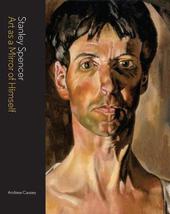
|
Stanley Spencer: Art as a Mirror of Himself
Hardback
Main Details
| Title |
Stanley Spencer: Art as a Mirror of Himself
|
| Authors and Contributors |
By (author) Andrew Causey
|
| Physical Properties |
| Format:Hardback | | Pages:192 | | Dimensions(mm): Height 270,Width 228 |
|
| Category/Genre | Art and design styles - c 1900 to c 1960
Painting and paintings
Individual artists and art monographs |
|---|
| ISBN/Barcode |
9781848221468
|
| Classifications | Dewey:759.2 |
|---|
| Audience | | Professional & Vocational | |
|---|
| Edition |
New edition
|
| Illustrations |
Includes 85 colour and 30 b&w illustrations
|
|
Publishing Details |
| Publisher |
Lund Humphries Publishers Ltd
|
| Imprint |
Lund Humphries Publishers Ltd
|
| Publication Date |
28 February 2014 |
| Publication Country |
United Kingdom
|
Description
Stanley Spencer (1891-1959) explored fundamental issues of life with an urgency and persistence unique among British artists of his generation. His art comments on religion, love, sexuality, fraternity and community. Charting the trajectory of Spencer's painting career in depth, this original publication provides a comprehensive analysis of the artist's oeuvre. Central to understanding Spencer's work is the man himself - deeply subjective, his paintings reflect the ideas and beliefs that motivated him. While he had less emotional attachment with his landscapes, he viewed each figure painting as constituent of a body of work which, viewed as a whole, was representative of his personal and professional evolution. Examining critically the artist's key works from all periods, Andrew Causey places Spencer's art within the wider context of the spiritual, social and even, exceptionally, political values that underpin his work and make him such an outstanding painter. While strong emphasis is placed on Spencer's 'visionary' paintings of the 1910s and1920s and the important crowd scenes and portraiture of the 1930s, Stanley Spencer gives due attention to the works produced later in the artist's career. The result is a well-rounded, original analysis of one of Britain's greatest painters that will enhance the libraries of general and specialist readers alike.
Author Biography
Andrew Causey wrote extensively on 20th-century art and was the author of books on Henry Moore, Paul Nash (his most recent published in 2013 by Lund Humphries), Edward Burra and Peter Lanyon. He contributed to exhibition catalogues on Stanley Spencer, Andy Goldsworthy and other artists and organised exhibitions at many venues including the Royal Academy, the Hayward Gallery, Tate and regional galleries and museums in the UK. He was Emeritus Professor of the History of Modern Art at Manchester University.
Reviews'This valuable and accessible introduction to an important English painter features extended discussion of key works-Swan Upping at Cookham, the Burghclere murals, the portraits (emphasizing "the close-up, scrutinizing his sitters"), and the WW II "Shipbuilding on the Clyde" series. Over 100 excellent color illustrations and a chronology are included. Highly recommended.' Choice As well as copious, generously sized illustrations, Andrew Causey provides a commentary that places Spencer's work in the context of his life. The whole is a thoroughly good read. (The Artist, September 2014) This is essential for any lover of the quintessentially English and endearingly eccentric work of Stanley Spencer ('Cookham' to his friends). If you're not converted, it'll make you a fan. A clear and useful introduction to Spencer's achievement [which] encourages us to look again at the paintings with renewed interest (Art Newspaper July 2014) A richly stimulating guide to a complex artist (Art Newspaper July 2014) Any book that can add to our understanding of genius - as this one does - is to be prized (Art Newspaper July 2014) Causey's book must be counted as one of the most important to have been written about Spencer. It is impossible to imagine anyone with an interest in the artist who would not learn a great deal from it, or that any future account could safely ignore it. Causey understands Spencer's absolute seriousness, and he reveals many of the complexities that underpinned it. It might not be too much to claim that, with the best parts of this book, Spencer criticism has entered a new phase of flexibility and intelligence. It is a fitting memorial to both author and artist. British Art Journal, July 2015
|